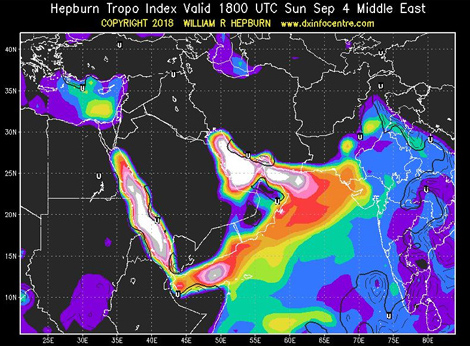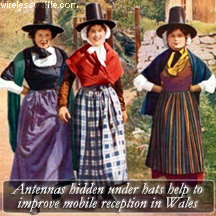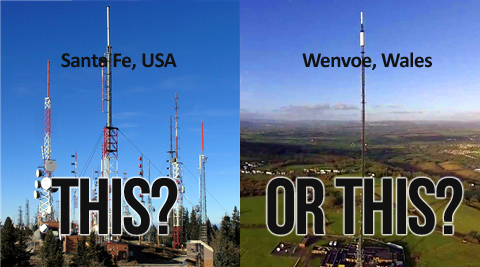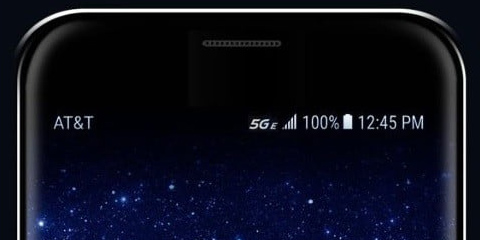Friday 8 March, 2019, 13:10 - Broadcasting, Licensed, Radio Randomness, Spectrum Management
Posted by Administrator
A while ago Wireless Waffle added an FM DX logbook listing reception of far distant (a.k.a. DX) FM radio stations which have been received in the UK at various times. Reception of such stations has also been discussed before in particular with reference to sporadic-E propagation. Posted by Administrator
FM stations being received over a long distance by sporadic-E tend to be very strong, and can often overwhealm reception of local stations. Those being received through tropospheric ducting are often somewhat weaker.
 It was a surprise, therefore, on a recent drive around London's orbital motorway, the M25, whilst listening to community station Kane FM at a distance of approximately 13 km from the transmitter, that french station France Inter on the same frequency of 103.7 MHz, became stronger. So much so, that the radio in the car decoded the RDS of France Inter and switched between 103.7 and 99.6 MHz where a second transmitter could be received.
It was a surprise, therefore, on a recent drive around London's orbital motorway, the M25, whilst listening to community station Kane FM at a distance of approximately 13 km from the transmitter, that french station France Inter on the same frequency of 103.7 MHz, became stronger. So much so, that the radio in the car decoded the RDS of France Inter and switched between 103.7 and 99.6 MHz where a second transmitter could be received.  The transmitter of France Inter on 103.7 MHz uses a massive power of 400 kW from a site in Lille (approximately 260 km away). It is actually one of the highest powered FM transmitters in the whole of Europe. The France Inter transmitter on 99.6 MHz uses a transmitter power of 50 kW from a site in Caen (approximately 225 km away). If you consider the free space path loss from these sites, and their transmitter power, you can roughly calculate the expected signal strength that each transmitter would produce.
The transmitter of France Inter on 103.7 MHz uses a massive power of 400 kW from a site in Lille (approximately 260 km away). It is actually one of the highest powered FM transmitters in the whole of Europe. The France Inter transmitter on 99.6 MHz uses a transmitter power of 50 kW from a site in Caen (approximately 225 km away). If you consider the free space path loss from these sites, and their transmitter power, you can roughly calculate the expected signal strength that each transmitter would produce.| Radio Station | Frequency | Power | Distance | Path Loss | Field Strength |
|---|---|---|---|---|---|
| Kane FM | 103.7 | 25 W | 13 km | 95 dB | 56 dBuV/m |
| France Inter (Lille) | 103.7 | 400 kW | 260 km | 121 dB | 72 dBuV/m |
| France Inter (Caen) | 99.6 | 50 kW | 225 km | 120 dB | 64 dBuV/m |
Assuming free space loss, therefore, the signals from France would be 8 to 16 dB higher than those from the nearby Kane FM transmitter.
However, this is nothing like reality: free space path loss gives a result which would represent the strongest possible signal that could be received. Of course none of the signals would be propagating in this way, as there would be innumerable obstacles along the way that would deviate wildly from 'free space' and the signals would come nowhere near these values, especially those that have travelled 200 km or more from France. Note that various studies have indicated that for reception in a car, a signal strength around 40 dBuV/m is needed suggesting that the additional path loss caused by propagation effects would have been in the order of 16 to 32 dB, which seems reasonable.
FM receivers have an effect called the 'capture ratio'. In general, if two signals are on the same frequency, and one is more than around 3 dB stronger than the other, then the strongest signal will win-out and the weaker one will disappear. So at least it is clear that the signal from France Inter on 103.7 was a few dB stronger from that of Kane FM.
None of this is groundbreaking nor even necessarily that interesting, but it does suggest that the actual path loss obtained during reception by tropospheric ducting can be relatively low. And for radio stations in areas prone to tropospheric ducting (predictions of which can be found on Willam Hepburn's excellent web-site), using a few extra dB of transmitter power may be necessary to ensure reliable reception. Stations, for example, on either side of the Arabian Gulf often use tens of kiloWatts of transmitter power even to provide coverage of just one city, as problems with ducting of signals from the other side of the Gulf are an almost daily occurrence.

Of course, the converse is that using more power then causes increased interference to those on the other end of the duct. Which in turn requires them to turn up their power to combat the problem. Which makes the problem worse. And so forth...
add comment
( 1335 views )
| permalink
| 



 ( 3.1 / 57754 )
( 3.1 / 57754 )




 ( 3.1 / 57754 )
( 3.1 / 57754 )
Thursday 21 February, 2019, 08:53 - 5G, Spectrum Management, Much Ado About Nothing
Posted by Administrator
Back in December of 2016, the UK Government's National Infrastructure Commission published its 'Connected Future' report. It recognised that:Posted by Administrator
government must take responsibility to secure our digital future ... Government must ensure we have the infrastructure in place to deliver 5G
Amongst the various proposals in the report, many are based on the recognition that 5G will require access to orders of magnitudes more base station sites than are currently deployed for 4G.
This makes a lot of sense. Local planning restrictions already hamper the roll-out of mobile services, not just because local councils think that cell sites are ugly, or even that they damage the environment or health, but the application procedure to get permission to install a site varies wildly from one council to another. Simplifying, harmonising and streamlining the process is essential if the UK, or indeed any country, is going to benefit from whatever it is that 5G is going to offer.
 It seems rather short-sighted then, that the Welsh Government is still pondering a change to what are know as Permitted Development Rights (PDR) to allow mobile operators to build masts with a height of 25 metres (82 feet) with reduced planning requirements. At present, in Wales, operators are only allowed to extend the height of their masts to 15 metres (50 feet), whereas in the rest of the UK, the limit is 25 metres.
It seems rather short-sighted then, that the Welsh Government is still pondering a change to what are know as Permitted Development Rights (PDR) to allow mobile operators to build masts with a height of 25 metres (82 feet) with reduced planning requirements. At present, in Wales, operators are only allowed to extend the height of their masts to 15 metres (50 feet), whereas in the rest of the UK, the limit is 25 metres. Wireless Waffle has previously discussed the relative merits of increasing transmitter power compared to increasing antenna height and demonstrated the importance of antenna height. In an area such as Wales where the difficulty in providing coverage is exacerbated by the hilly terrain, and where a large number of mobile 'not-spots' exist, antenna height is of even greater importance. The reluctance to increase the permitted tower height comes in stark contrast to a previous move by the Welsh Government to invest £150 million in trying to provide coverage in these not-spots.

There is no doubt a fear that higher masts will make the countryside look ugly or cluttered, but the counter-balancing effect is that taller masts, means fewer masts. Imagine how many TV transmitter towers there would need to be if their height was limited to 15 metres. If Wales is to rise out of the valleys in terms of mobile coverage, the Welsh Government needs to act quickly, i.e. before 5G comes along, to ensure that the existing not-spot problems are not further heightened (see what we did there?)
As they say in Wales: "Nid yw tegell llawn caws yn cael ei ddefnyddio i ffôn symudol gyda chalon wedi'i dorri."
No sooner has 2019 begun than the 5G hype wagon has been set off over the dusty plains being drawn by a load of dog-eared donkeys with lazy, do-nothing yokels riding on the back of it. This week it is the turn of US mobile giant AT&T who have somehow convinced Apple to update the firmware in their iPhone to show '5G' (or more precisely '5G E') as the network to which it is connected.

But the network isn't 5G, it's 4G. AT&T don't have a 5G mobile network.
A while ago, Wireless Waffle attempted to demystify the various network type indicators that are shown on mobile phones. If this can be fudged by mobile operators or mobile handset manufacturers, then expect to see lots of new '5G' services sprouting up any time soon. What will the operators then do when they actually launch 5G? 6G here we come...!

But the network isn't 5G, it's 4G. AT&T don't have a 5G mobile network.
A while ago, Wireless Waffle attempted to demystify the various network type indicators that are shown on mobile phones. If this can be fudged by mobile operators or mobile handset manufacturers, then expect to see lots of new '5G' services sprouting up any time soon. What will the operators then do when they actually launch 5G? 6G here we come...!
 2018 was hopefully the year in which 5G hype peaked. Lots of mobile operators and equipment manufacturers were desperate to jump on the band-wagon and proclaim their plans to launch or operate 5G services or devices to be the first out of the running blocks. The simple fact, however, was that the 5G standard was delayed for 3 months until June 2019, and as of yet, there is no internationally agreed spectrum for 5G services.
2018 was hopefully the year in which 5G hype peaked. Lots of mobile operators and equipment manufacturers were desperate to jump on the band-wagon and proclaim their plans to launch or operate 5G services or devices to be the first out of the running blocks. The simple fact, however, was that the 5G standard was delayed for 3 months until June 2019, and as of yet, there is no internationally agreed spectrum for 5G services.2019 will hopefully be the year in which some of the hype begins to melt, and reality sets in. Prime amongst this will be the decisions taken at the ITU's World Radiocommunications Conference (WRC-19) which is due to take place in Sharm El-Sheikh in Egypt in November. One of the Agenda Items for the confernence, if not the most important agenda item of the conference, is number 1.13, whose snappy title is:
To consider identification of frequency bands for the future development of International Mobile Telecommunications (IMT), including possible additional allocations to the mobile service on a primary basis, in accordance with Resolution 238 (WRC-15).
 IMT is the ITU's terminology for commercial mobile communications and there are actually three flavours, IMT (2G and 3G), IMT-Advanced (4G) and IMT-2020 (5G). Before any radio spectrum can be formally used for IMT services of any kind, there are two prerequisites. Firstly the spectrum must have a 'mobile' allocation in the country in which it is to be used. Such an allocation will be found in the country's national frequency allocation plan. And in theory, if it is to be used for mobile services, it should also have been identified by the ITU as spectrum for IMT. All of the current mobile bands (e.g. 700, 800, 900, 1800, 2100, 2600 MHz) are in pieces of spectrum that have this identification.
IMT is the ITU's terminology for commercial mobile communications and there are actually three flavours, IMT (2G and 3G), IMT-Advanced (4G) and IMT-2020 (5G). Before any radio spectrum can be formally used for IMT services of any kind, there are two prerequisites. Firstly the spectrum must have a 'mobile' allocation in the country in which it is to be used. Such an allocation will be found in the country's national frequency allocation plan. And in theory, if it is to be used for mobile services, it should also have been identified by the ITU as spectrum for IMT. All of the current mobile bands (e.g. 700, 800, 900, 1800, 2100, 2600 MHz) are in pieces of spectrum that have this identification.The Agenda Item is investigating a wide range of frequency bands ranging from 24.25 to 86 GHz.
| Frequency Range | Amount of Spectrum |
|---|---|
| 24.25 - 27.5 GHz | 3.25 GHz |
| 31.8 - 33.4 GHz | 1.6 GHz |
| 37.0 - 43.5 GHz | 6.5 GHz |
| 45.5 - 50.2 GHz | 4.7 GHz |
| 50.4 - 52.6 GHz | 2.2 GHz |
| 66.0 - 76.0 GHz | 10.0 GHz |
| 81.0 - 86.0 GHz | 5.0 GHz |
| TOTAL | 33.25 GHz |
In total an increadible 33 GHz of new spectrum is being examined, which is in the order of 30 times more than has been identified as of today. Of this, it seems likely that something in the region of 20 GHz of spectrum will be identified for IMT. However, the waters are already being muddied by the organisations that manufacture mobile equipment and devices, and by one or two influential countries (e.g. the USA, Japan and China), and the nascent 5G standard includes the use of spectrum that is not part of the Agenda Item's studies.
In particular, the US, Japan and South Korea and others are proposing the use of a 28 GHz band (27.5 - 29.5 GHz) and South Korea, Japan and China are considering the use of a 4 GHz band (4.4 - 5.0 GHz), both bands, as it happens, being currently used for commercial satellite services. As these bands are not on the agenda for WRC-19, in theory they can not be identified for IMT meaning that they would be 'non-harmonised' bands. But in today's fast moving mobile industry, what really constitutes 'harmonised'? Does it mean that it has gone through the laborious 4 year ITU conference cycle, or does it mean that enough countries with sufficiently large populations to encourage economies of scale in manufacturing have got together and agreed a way forward.
 Many question the validity of the ITU process, saying that it is outdated, lethargic and even irrelevant. Some are even threatening to withdraw themselves, and their funding, from the organisation. That being said, it remains the process that most of the almost 200 members of the United Nations turn to, to help them align their use of the radio spectrum with the rest of the planet.
Many question the validity of the ITU process, saying that it is outdated, lethargic and even irrelevant. Some are even threatening to withdraw themselves, and their funding, from the organisation. That being said, it remains the process that most of the almost 200 members of the United Nations turn to, to help them align their use of the radio spectrum with the rest of the planet.The forthcoming WRC therefore, and the associated decisions on the frequency bands to use for 5G, stands to be fascinating, both from the perspective of the sheer amount of new mobile spectrum that could be available following the conference, and whether or not the rogue nations will be able to twist enough arms to get their positions ratified, or will just storm out of the room in a huff. Wireless Waffle, will, as always, keep you posted.


